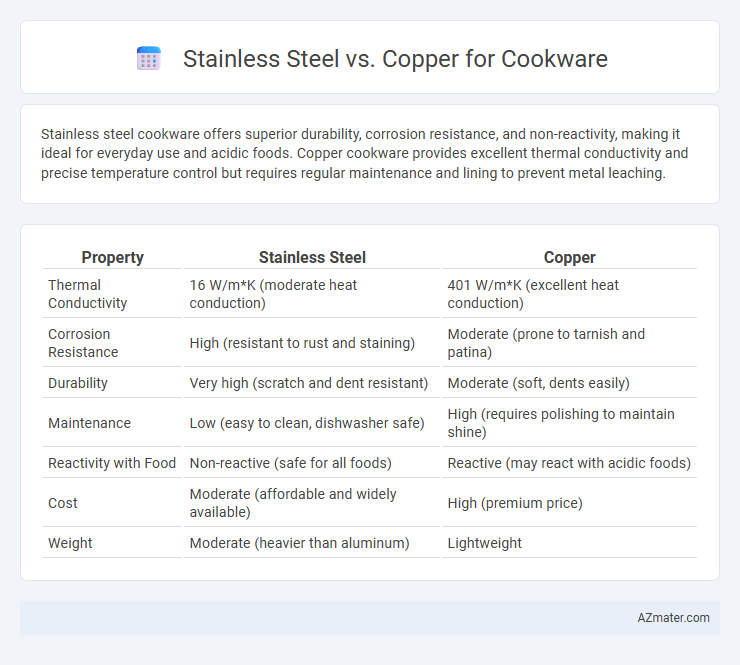Stainless steel cookware offers superior durability, corrosion resistance, and non-reactivity, making it ideal for everyday use and acidic foods. Copper cookware provides excellent thermal conductivity and precise temperature control but requires regular maintenance and lining to prevent metal leaching.
Table of Comparison
| Property | Stainless Steel | Copper |
|---|---|---|
| Thermal Conductivity | 16 W/m*K (moderate heat conduction) | 401 W/m*K (excellent heat conduction) |
| Corrosion Resistance | High (resistant to rust and staining) | Moderate (prone to tarnish and patina) |
| Durability | Very high (scratch and dent resistant) | Moderate (soft, dents easily) |
| Maintenance | Low (easy to clean, dishwasher safe) | High (requires polishing to maintain shine) |
| Reactivity with Food | Non-reactive (safe for all foods) | Reactive (may react with acidic foods) |
| Cost | Moderate (affordable and widely available) | High (premium price) |
| Weight | Moderate (heavier than aluminum) | Lightweight |
Introduction: Stainless Steel vs Copper Cookware
Stainless steel cookware offers excellent durability, resistance to rust and corrosion, and a sleek, modern appearance, making it a popular choice for everyday cooking. Copper cookware provides superior heat conductivity, allowing for precise temperature control and rapid heat responsiveness, favored by professional chefs for delicate cooking tasks. While copper requires regular polishing to maintain its shine, stainless steel is prized for its low maintenance and versatility in various cooking styles.
Heat Conductivity and Distribution
Copper cookware offers superior heat conductivity with a rate of approximately 400 W/mK, ensuring rapid and even heat distribution across the cooking surface. Stainless steel, with a much lower thermal conductivity around 16 W/mK, tends to heat unevenly unless paired with an aluminum or copper core to enhance heat distribution. This difference makes copper ideal for precise temperature control, while stainless steel offers durability but requires layered construction for optimal thermal performance.
Durability and Longevity Comparison
Stainless steel cookware offers exceptional durability due to its resistance to rust, corrosion, and warping, making it ideal for long-term use. Copper cookware, while prized for superior heat conductivity, requires regular maintenance to prevent tarnishing and can be prone to denting or scratching. Overall, stainless steel provides a longer lifespan with less upkeep, whereas copper demands careful handling to maintain its durability.
Reactivity with Foods
Stainless steel cookware features low reactivity, making it ideal for cooking acidic or alkaline foods without altering taste or causing discoloration. Copper cookware, highly reactive with acidic ingredients, can release metallic ions that affect food flavor and potentially health, often requiring a protective lining. Choosing stainless steel ensures durability and non-reactive cooking, while copper provides superior heat conductivity but demands more careful maintenance and food pairing.
Maintenance and Cleaning Requirements
Stainless steel cookware demands minimal maintenance, offering resistance to rust and corrosion with simple hand washing or dishwasher use, and it typically does not require seasoning. Copper cookware requires more intensive upkeep due to its susceptibility to tarnish and oxidation, often needing regular polishing with specialized cleaners to maintain its appearance and performance. Copper's reactive surface can also necessitate careful cleaning to avoid damage, making stainless steel a more convenient option for daily use.
Weight and Handling
Stainless steel cookware is generally heavier than copper, providing a sturdy and durable feel that enhances stability while cooking. Copper cookware offers superior heat conductivity and is lighter, allowing for more agile handling and precise temperature control. However, copper requires more careful maintenance to preserve its finish and performance compared to the more resilient stainless steel.
Aesthetic Appeal and Design
Stainless steel cookware boasts a sleek, modern appearance with a polished or brushed finish that complements contemporary kitchen designs, offering durability against scratches and stains. Copper cookware captivates with its warm, rich tones and natural patina that develop over time, making it a favorite for artisanal and vintage aesthetics. While copper provides superior heat conductivity, stainless steel's versatility in design and ease of maintenance make it a popular choice for both functional and visually appealing kitchenware.
Price and Value Considerations
Stainless steel cookware offers a cost-effective option with durable, corrosion-resistant properties, making it ideal for budget-conscious buyers seeking long-term value. Copper cookware, while significantly higher in price, provides superior heat conductivity and precise temperature control, benefiting professional chefs and serious home cooks. Evaluating the initial investment versus cooking performance and maintenance requirements helps determine the best choice for individual culinary needs.
Popular Brands and Market Trends
Popular brands like All-Clad and Cuisinart dominate the stainless steel cookware market, favored for durability and dishwasher safety, while Copper Chef and Mauviel lead in copper cookware, prized for superior heat conductivity and precise temperature control. Market trends indicate a growing consumer preference for hybrid cookware combining stainless steel and copper to balance performance and maintenance. Demand for sustainable and non-toxic materials drives innovation, with copper's natural antimicrobial properties gaining appeal amid health-conscious buyers.
Choosing the Right Cookware for Your Kitchen
Stainless steel cookware offers durability, resistance to rust, and even heat distribution, making it ideal for everyday use and high-temperature cooking. Copper cookware provides superior thermal conductivity for precise temperature control, preferred by professional chefs for delicate sauces and quick temperature changes. Choosing between stainless steel and copper depends on your cooking style, maintenance preferences, and budget, with stainless steel being low-maintenance and copper requiring regular polishing to maintain its appearance.

Infographic: Stainless steel vs Copper for Cookware
 azmater.com
azmater.com